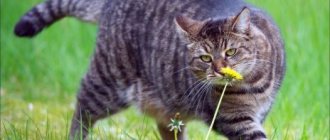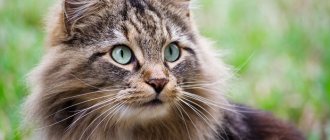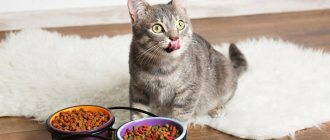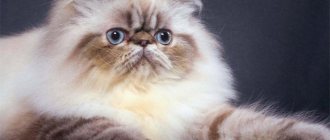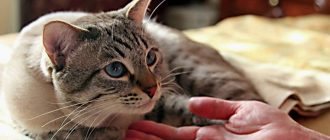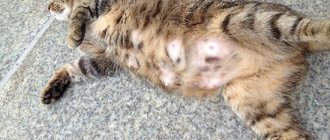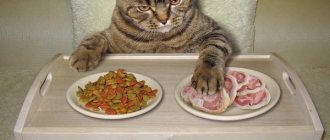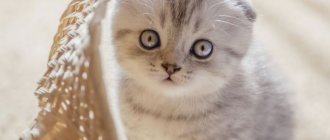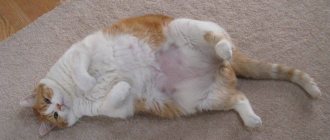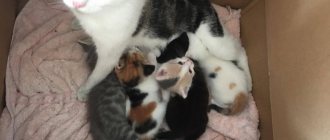How to tell if your cat needs to lose weight
In most cases, obesity develops gradually: if you see your pet every day, you may not notice changes in its appearance or behavior. The main signs indicating the need to lose excess weight include:
- Decreased pet activity. If your cat used to constantly play with a ball or jump on the highest cabinets and shelves, now he prefers to spend most of his time on the sofa or bed. Refusal from active play may be associated with joint pain or the development of shortness of breath, which occurs in an obese animal even with minor exertion.
- External changes. In healthy cats, bony protrusions (ribs, spine) can be easily felt and they have developed dense muscles. With obesity, the animal's waist flattens out, and a hanging belly and fat folds may appear. It is almost impossible to palpate bony landmarks.
- Increased appetite. If you previously fed your furry friend 3-4 times a day, then gradually the number of feedings increases. The animal greedily eats a portion of food and returns for more: there is no satiety due to a distended stomach.
Photo gallery: what obese cats look like
It is more difficult for an overweight cat to move around
Obesity causes sagging of the lower abdomen
Obesity is characterized by a flattened waist or its complete absence
The main factors for gaining excess weight in cats
In most cases, the cause of cat obesity is improper nutrition. The owner overfeeds the pet or adds too much fat and fast carbohydrates to the diet. However, there are other factors that influence excess weight gain:
- sedentary lifestyle: lazy cats are much more prone to obesity;
- castration or sterilization (changes in hormonal levels create the preconditions for gaining excess weight);
- stressful situations (change of residence, appearance of a new pet);
- pregnancy in a cat;
- availability of food in free access;
- abuse of treats;
- consequences of the operation (long-term immobility);
- diseases of the endocrine system requiring medication;
- belonging to some breeds (British cat, Scottish fold, Persian).
Video: veterinarian talks about obesity in animals
Why can't you feed a cat?
Cats are still better off than us women - a plump cat looks much cuter, everyone is touched and rewarded with additional tasty pieces. No reproachful glances - just a double portion of love from the hosts and guests!
But in fact, this is bad - people like to pet an overweight cat
, they feed him, the cat, of course, eats - and at this
time his health suffers
!
Neutered male cats are especially
– their metabolism is slightly changed compared to uncastrated animals, so you need to carefully monitor the weight of such cats!
What are the dangers of obesity for cats?
? Cardiovascular problems, shortness of breath, liver problems, the risk of developing diabetes - in general, all those diseases that threaten fat people!
How to organize food for overweight cats
When treating obesity in animals, veterinarians are guided by the same principles as nutritionists: the number of calories consumed should be less than their daily expenditure. Such a deficiency creates conditions for burning fatty tissue and allows the pet to quickly get into shape.
To achieve normal body weight, you can use both ready-made food and natural food (at the discretion of the owner).
Basic rules for creating a diet for obese cats:
- Monitor the quality of your food. Use only special food of at least premium class. The economy segment can cause additional health problems in cats. For the same reason, it is recommended to purchase only proven and fresh products when organizing natural nutrition.
- Provide access to clean water. Many cats with a fluid deficiency begin to eat more food to compensate for this deficiency. The water in the bowl should be changed at least twice a day to prevent dust, hair, and food debris from accumulating in it.
- The cat should be fed often, but in small portions. It is better to choose a specific time for this (8, 12, 16, 18, 22, 24 hours). And also stop any begging or food theft by the animal: treats also contain extra calories.
One of my friends’ cat gained a lot of weight over the winter: he gained about 4 extra pounds, which had a negative impact on his health. The owner decided to review his diet and strictly limited his food, and also regularly forced the cat to run after toys. For several months, she tried different types of food, but the furry pet’s weight stubbornly remained the same. The woman was about to seek help from a veterinarian, but one night she caught her husband in the kitchen, together with the cat, finishing a loaf of doctor’s sausage. Such nutrition negated all the daily efforts of the housewife. The husband was given a severe reprimand, and the furry purr was put on a strict diet, after which he still managed to get back into shape.
Why does a cat need to lose weight?
For each animal there is a weight norm at which they feel great and look beautiful. An extra layer of fat cells increases the load on internal organs, disrupts the functioning of systems, leads to the development of diseases, and increases the risk of complications in existing chronic pathologies. Cats that are overweight or obese move little, do not play, lead a passive lifestyle, age faster, and live less. An animal needs to lose weight for itself and its owner. To prevent pathological transformations, diseases, play, run, lead a full life.
The causes of obesity are:
- type 2 diabetes mellitus;
- violation of metabolic processes;
- heart diseases;
- arthritis, osteoarthritis;
- high blood pressure;
- sore joints;
- oncology;
- hormonal imbalance;
- poor nutrition;
- sedentary lifestyle.
It is worth noting that wild cats practically do not suffer from excess weight or obesity, and they get sick less. Pets move little, eat artificial food, and are sterilized, so their lifestyle can hardly be called healthy or life fulfilling. To avoid health problems for your pet, the owner must make every effort. Fat cats suffer from various diseases, have problems with blood vessels and muscles.
What ready-made food should you use to reduce your pet’s weight?
For the safe and slow treatment of obesity, a whole line of special veterinary foods has been developed. Unlike regular nutrition, they are aimed at eliminating excess weight and preventing further weight gain. The main advantages of using such feeds include:
- the ability to choose various flavorings;
- no time spent on cooking;
- long-term storage of feed;
- the effectiveness of such nutrition has been proven by veterinarians;
- the presence of the necessary components in the composition and a strict calculation of caloric content (in most cases, additional administration of vitamins and mineral components is not required);
- using a special feeder with timers to dispense a portion of a certain volume.
Mechanism of action and composition of dietary cat food
Medicinal food differs significantly from regular food. It contains much less fat and carbohydrates, which helps reduce the overall calorie intake. The mechanism of action of such food is to ensure longer saturation, stimulation of the gastrointestinal tract and normalization of metabolic processes in the cat’s body. This is achieved due to a certain balance of nutrients. The low-calorie food contains the following components:
- Plant fiber (beet pulp, bran, chopped oats, corn flour, brown rice, spinach). It acts as a natural scrub for the intestines, improving intestinal motility and stimulating timely bowel movements.
- Animal protein (processed beef, fish, poultry). Its amount is several times higher than the level of fats and carbohydrates, which allows you to burn excess fat without losing muscle mass.
- L-carnitine, taurine, mineral complexes and vitamins B, C, A, E. These components accelerate metabolic processes and restore the body’s need for various macro and microelements.
Is it possible to use diet food without consulting a specialist?
You should only select specialized food yourself if you have the appropriate education. When selecting a diet for obese cats, the doctor must take into account the breed of the animal, its weight, and the individual characteristics of the body. This allows you to determine the required calorie content, calculate the number of feedings and the volume of one serving. Before prescribing certain foods, blood tests should be taken to identify possible damage to the liver and digestive tract.
Contraindications to the prescription of dietary nutrition are pregnancy, lactation and age under one year.
How long should you feed your cat medicated food?
In order not to harm your pet’s health, it is necessary to reduce its body weight gradually (no more than 0.5–1% per week). On average, low-calorie food is prescribed for a period of 6 months to a year, after which the cat’s condition is monitored. In some cases (old age, upcoming surgery, certain breeds), the animal must adhere to such a diet throughout its life. This provides reliable prevention of further progression of obesity and increases life expectancy by several years.
It is also worth transitioning your cat to regular food gradually. One of my colleagues had a Persian cat who ate only dietary food for a year, which quenched his appetite and helped him stay in shape. The owner decided that the result had been achieved: the pet could be switched to its usual diet, after which it began to buy regular economy-class food. This diet is characterized by insufficient balance and a minimal amount of fiber. As a result, due to a lack of nutrients, the cat began to regularly steal food from the table, which caused stomach illness. The owners turned to the veterinarian, who selected the best food for them in terms of price and composition.
Is it possible to mix diet food with regular food?
Veterinarians do not recommend combining two foods with each other, since they have completely different energy values and composition. This leads to a significant decrease in the effect of dietary nutrition and the process of treating obesity slows down. But for many cats, a sudden change in diet can become very stressful: in this case, it is permissible to combine two foods with each other. Veterinarians recommend switching the animal to a new food within a week, gradually replacing the old one.
Changing food will be painless if the new food is introduced gradually
What weight is considered normal for a cat?
It all depends on the breed
!
Let’s just say that an adult cat (mongrel or purebred of “standard” sizes) should weigh on average 3-5 kg
.
But this is not the norm for all breeds - for example, large breeds such as Maine Coons or British Shorthairs (especially male cats - they usually weigh more than cats
) can gain 7-9 kg, which does not mean obesity!
And for graceful miniature breeds - “Sphinxes”, Orientals, Abyssinians, etc. – and 5 kilos is already excessive!
Veterinarians offer another way to determine whether it’s time for a cat to lose weight - lay the animal on its side and look at the side line - the stomach should not “stick out” from the side!
In addition, you just need to observe the cat’s behavior
– plump cats experience shortness of breath, they move little and rarely play, and the need for water and food increases. If these signs are present, you should think about how to lose weight for a cat!
Table: comparative characteristics of dietary feeds of various brands
| Name of food | Class | View | Flavors | Peculiarities | Price |
| Eukanuba Adult Sterilized Weight Control Chicken | Superpremium | Dry | Chicken | Designed for sterilized and neutered male cats |
|
| Hill's Prescription Diet Metabolic Weight Management | Superpremium | Dry | Chicken | Allows you to maintain optimal weight |
|
| Hill's Prescription Diet Metabolic + Urinary Weight Care | Superpremium | Dry | Chicken, turkey | Also used for cats with urinary tract diseases |
|
| Hill's Prescription Diet i/d Digestive Care (jelly) | Superpremium | Wet | Chicken | Helps maintain a healthy digestive tract |
|
| Hill's Prescription Diet w/d Digestive/Weight Management | Superpremium | Dry | Chicken | Helps normalize weight in diabetic cats |
|
| Hill's Prescription Diet w/d Digestive/Weight Management (jelly) | Superpremium | Wet | Chicken | Better absorbed by the pet's stomach |
|
| Royal Canin Satiety Weight Management SAT34 | Superpremium | Dry | Chicken, poultry | Can be used for diabetes and urolithiasis |
|
| Royal Canin Neutered Adult Maintenance | Superpremium | Wet | Chicken, pork, poultry, liver | Suitable for sterilized animals in the postoperative period |
|
| Pro Plan Veterinary Diets Feline OM Obesity (Overweight) Management dry | Premium | Dry | Chicken, poultry | Used for adult cats |
|
| Farmina Vet Life Natural Diet Cat Obesity | Premium | Dry | Chicken, pork, poultry | Prevents muscle loss | 2 kg - 1709 rub. |
| Royal Canin Satiety Weight Management (jelly) | Superpremium | Wet | Chicken | Suitable for pets with diabetes |
|
| Purina Pro Plan Veterinary Diets OM pouches | Superpremium | Wet | Chicken | Helps maintain weight |
|
| Happy Cat Adipositas | Superpremium | Dry | Chicken, poultry | Also used for cats with liver disease |
|
| Brit VDC Obesity | Superpremium | Dry | Chicken | Suitable for British cats, grain free | 2 kg - 1240 rub. |
| Forza10 Active Line | Superpremium | Dry | Fish | Consists of heart-shaped granules | 454 g - 470 rub. |
| Enova Breeder Cat Light Indoor | Superpremium | Dry | Chicken, rice | Can be used to feed cats over 7 years of age | 10 kg - 6300 rub. |
| Bosch Sanabelle Light for cats prone to obesity | Superpremium | Dry | Bird | Provides quick satiety due to the large amount of dietary fiber | 2 kg - 1300 rub. |
| Barking Heads Adult Fat Cat Slim | Holistic | Dry | Chicken, salmon | Suitable for pets with sensitive stomachs |
|
| 1st Choice Weight Control | Superpremium | Dry | Chicken | Designed for adult animals | 5.5 kg - 2600 rub. |
Photo gallery: examples of dietary foods
Hill's Prescription Diet i/d Digestive Care stimulates the stomach and intestines Purina Pro Plan Veterinary Diets OM pouches improves digestion Royal Canin Satiety Weight Management comes in jelly form Forza10 Active Line has an original heart-shaped granule shape Happy Cat Adipositas helps reduce weight in cats with disease liver Hill's Prescription Diet w/d Digestive/Weight Management is used for cats with diabetes Hill's Prescription Diet Metabolic Weight Management helps maintain proper body weight Pro Plan Veterinary Diets Feline OM Obesity allows you to quickly lose excess weight
How to calculate your cat's calorie needs
The weight loss formula for cats is based on the cat's resting energy requirement (the number of calories a cat needs when not physically active, or PEED), which is calculated as follows:
- Method: PEPP in kcal/day = 70 x (ideal weight in kg) x by ¾;
- Method: PEPP in kcal/day = 30 x (total weight in kilograms) + 70.
To lose weight, a cat must receive 80% of the PEPP (multiply the PEPP by 0.8). In order not to waste time on calculations, you can use the table:
Ideal Weight: lbs (kg)
Calories that make up 80% of your daily nutritional intake
Please note: These are general guidelines and cannot replace the advice of your veterinarian. If your cat is unable to lose weight by consuming the specified amount of calories, it should be reduced.
Feeding Obese Cats Natural Products
If your animal has gained excess weight on a natural diet, you should also reconsider its diet. Don't forget that a healthy adult cat's diet should include proteins and fats of animal origin. You shouldn’t suddenly switch your furry pet to plant foods or greatly reduce portion sizes: this will only provoke unnecessary stress. Veterinarians recommend using the following products to feed overweight cats:
- Meat, offal and fish contain the required amount of protein and essential amino acids. Lean beef, rabbit, chicken or turkey are suitable for dietary nutrition. Of the by-products, preference should be given to hearts and liver. Meat should be served boiled or fresh frozen to destroy helminths. For dietary nutrition, steamed sea fish (trout, salmon) is mainly used.
- Milk based products. Kefir, cottage cheese, fermented baked milk, goat cheese, bifidok are sources of calcium and easily digestible protein, so they must be included in the cat’s diet. Please note that their fat content should not exceed 2–5%.
- Porridge and cereals. The fiber they contain provides satiety and acts as a natural scrub for the intestines, removing toxins. Cereals that are healthy for cats include rolled oats, brown rice, and millet. They need to be boiled in water or chicken broth.
- Greens and vegetables. They are used as an additive to cereals or meat: they should be boiled and ground in a blender. The best foods for feeding cats are spinach, celery, zucchini, squash, green beans, carrots, broccoli, and cauliflower.
Photo gallery: healthy foods for pets
By-products contain the required amount of protein
Dairy products are rich in calcium
Vegetables are the best source of vitamins and minerals
It is harmful to feed cats from the home table: our food contains a large amount of salt and various additives that negatively affect their health. Such a diet contributes to the development of obesity and other dangerous diseases. Veterinarians strictly prohibit giving overweight cats the following foods:
- sausage, frankfurters, small sausages;
- semi-finished products (cutlets, zrazy, dumplings);
- butter;
- chicken skin and fat from meat;
- bones;
- processed cheese;
- ice cream;
- sweet yoghurts and curds.
Increased pet's motor function
But dietary nutrition alone is not enough for the animal’s weight to normalize and remain that way for a long time. The type of life the pet leads plays an equally important role. If the cat still only eats and sleeps, then unspent calories will soon begin to accumulate in the body again. As an example, you can look at cats living on the street or in the wild - no extra calories or excess body weight. From this we can conclude that the owners themselves are unwittingly shortening the life of their pet, depriving their cats of one of the most important components of their lives, namely physical activity. It is important to remember that an animal living at home may constantly eat simply out of boredom, when there is nothing else to do, so you need to devote as much time as possible to it.
Essential vitamins and mineral complexes
When organizing natural nutrition, it is quite difficult to take into account the cats’ need for vitamins and minerals when preparing a diet. Often, in their absence, metabolic processes slow down and various diseases can develop. To avoid such complications, you need to contact your veterinarian to select the optimal complex of vitamins and mineral components. They usually come in the form of pleasant-smelling tablets that can be crushed finely and added to your cat's food.
Give preference to proven products from a veterinary pharmacy. For example, adding crushed shells to an animal’s diet is not welcomed by veterinarians, as it can lead to digestive disorders.
The most popular vitamins and mineral complexes for cats:
- Beaphar Top 10 (contains taurine);
- Canina Cat-Vitamin Tabs;
- VetExpert VetAminex;
- Doctor Zoo "Health and Beauty";
- Dreamies pillows with chicken and taurine;
- Phytomines for castrated cats;
- Gimpet Schnurries (to normalize metabolism);
- Nutri-Vet Wild Alaskan Salmon Oil.
Please note that vitamins should be stored out of the reach of cats. Once, on the advice of a veterinarian, I bought vitamins for my cat, which he liked. I accidentally left the box on the table, which my pet took advantage of. He ate about half of the tablets, which did not affect his health in any way, but led to a complete aversion to them. The cat completely refused vitamins for several months.
Photo gallery: vitamins and mineral complexes
Canina Cat-Vitamin Tabs - multivitamin complex
Doctor Zoo is a domestic brand
Phytomines are used for castrated cats
How to get yourself moving more
You cannot take your cat with you on your morning jog. This behavior is not typical for an animal. Cats are ambush predators who, by nature, do not move very much, wait for prey in ambush, and rarely go beyond the boundaries of their own territory. If necessary, they give chase at their maximum speed, but the duration of the run is no more than 1 minute. After this, the predator needs a lot of time to recuperate.
A domestic cat is a copy of a wild cat, but even more immobilized. Making an adult pet tumble, run after a ball, and fatten up is problematic. Moreover, if the animal has led a sedentary lifestyle for several years. In addition, breed and character traits play an important role. Some cats simply don’t tend to frolic, roll up rugs, or chase a target.
To reduce the number of calories and reduce the accumulation of fat cells, you can do the following:
- tease your pet, forcing him to chase a toy or ball;
- do gymnastics;
- use special toys that stimulate the cat’s activity;
- install feeders with slots;
- create barriers to access to the bowl of food, for example, place it on a platform higher than usual, then the pet will have to strain;
- make a cut in a plastic bottle, put food there, the cat will be forced to roll the “feeder” to get to the food;
- install a running wheel for cats.
Pets who have the opportunity to go outside suffer less from obesity because they move more. If possible, you need to start taking your pet for walks. Cats do the most primitive exercises for losing weight - legs to the sides, up.
How to feed other cats if only one needs to lose weight?
You may find a better solution to the problem, but here are some tips to get you started:
- Feeding cats separately is the ideal solution for such cases. Give your losing cat some diet food in one room and feed the rest in another. When the time allotted for a meal is over - usually from fifteen minutes to half an hour - remove what the animals did not eat until the next feeding.
- Feed a cat that is not overweight at the top, where it is more difficult for an overweight cat to climb.
- Never leave food out in the open unattended. This way you won’t be able to control who eats what and when!
How long does it take to train a cat to go on a diet?
Give your cat a week or two to get used to the new diet. First, mix ¼ of the new food with ¾ of the usual food for 2 to 4 days. Then increase the amount of new food to half, and in the last 3 to 5 days before the final transition to the new diet - to ¾.
To improve palatability, you can heat the food and add flavoring additives, for example, based on fish oil containing Omega-3 fatty acids.
If your cat refuses a new diet, or if you have any questions while introducing her to a new food, do not hesitate to contact your veterinarian for advice.
